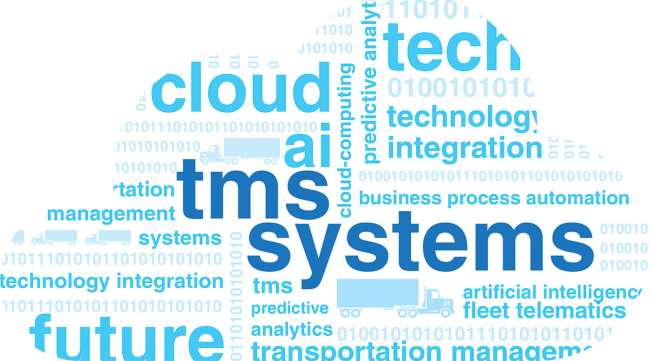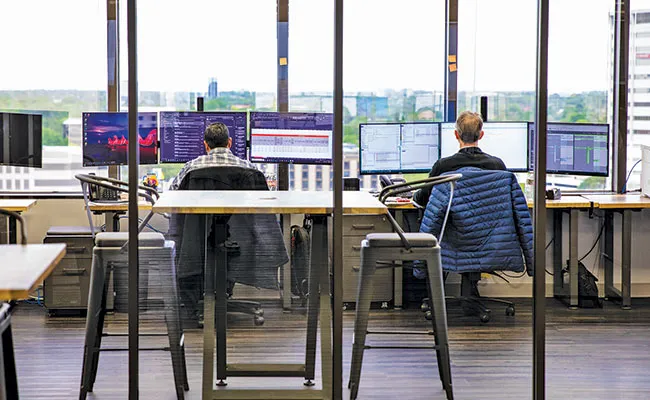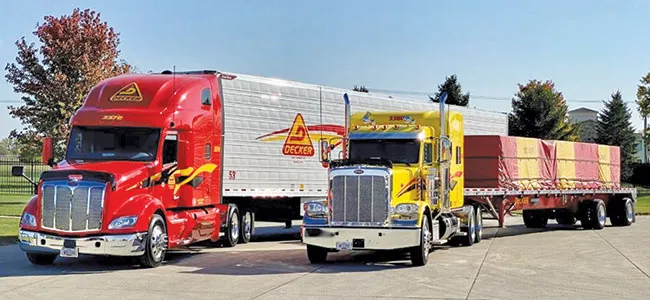AI, Analytics, Automation Drive the Development of TMS

[Stay on top of transportation news: Get TTNews in your inbox.]
From the stand-alone dispatching software of the past to today’s complex, integrated technology platforms that leverage cloud computing, transportation management systems have evolved to provide real-time data and advanced analytics to improve freight visibility and fleet decision-making.
“Initially, the systems didn’t do much more than freight bill and print the driver a paycheck. We were replacing typewriters,” said Tom McLeod, CEO of McLeod Software, which he founded in 1985. “What we’ve seen are gradual and incremental improvements being made year by year. Over time, there has been a lot of change.”
Along the way, the level of complexity in the supply chain and shippers’ expectations for their motor carriers have increased.
“As a result, the systems have had to adapt,” said Jay Delaney, director of product management for Magnus Technologies.
Today’s TMS systems are capable of managing the entire transportation life cycle.
“They offer a wide range of features, including carrier management, freight procurement, order management, freight auditing and analytics,” said Justin Bailie, co-founder of Rose Rocket.

Bailie
Ben Wiesen, president of Carrier Logistics Inc., said fleets can now use software systems to help manage virtually every part of their operations.
“Those systems do everything from optimizing truck routing to managing terminal labor to automating invoicing and payments,” he said.
Modern TMS systems also allow users to customize their software with specific functionalities to meet the unique needs of their businesses.
The levels of customization, capabilities and efficiencies are expected to increase through the continued integration of emerging technologies, artificial intelligence and machine learning.
“By the end of this decade, computers won’t just be eliminating clerical hours, they will be making autonomous decisions which manage the fleets in ways that currently require dispatchers, load planners and operations supervisors,” Wiesen said.
Jessica Pancich, director of product management at Solera, noted that systems have become more flexible, efficient and connected with the TMS collecting and sharing information.
“We’re all striving to make the TMS the mothership, so the TMS is your sole operation platform,” she said.

McLeod Software offices. TMS vendors are harnessing data analytics and artificial intelligence to provide actionable insights for customers. McLeod combines data and machine learning to predict rates and how they are trending weeks in advance. (McLeod Software)
Technology Integrations
Early on, systems didn’t need to integrate with outside technology vendors, but robust third-party integrations are now essential.
“We need to have connectivity, and we need our TMS to be a baseline platform to provide a unified, seamless experience for the team,” said Walter Mitchell, CEO of Tai Software.
The systems pull together data from other sources, such as electronic logging devices, and use real-time data to customize workflows, automate processes and improve human decision-making, explained Hans Galland, CEO of BeyondTrucks.
Because connectivity is crucial, Trimble is making it easier and faster to integrate with third parties.

Williams
“We have to be thoughtful about how important even those competitor partners are in moving this industry forward because, at the end of the day, it is about the movement of goods,” said Kelly Williams, network strategy product lead for Trimble.
Cloud computing has changed the game, making connectivity and data-sharing more common and systems more cost-effective, said Mike Hane, director of TMS product marketing for Descartes.
“It has brought this technology to the masses,” he said.
TMS providers said carriers are using these systems to create workflows and automate tasks, including dispatching, driver payment and customer invoicing.
“Automation is riddled all through the operational activities,” Solera’s Pancich said.
Decker Truck Line, a refrigerated and flatbed carrier based in Fort Dodge, Iowa, has used its TMS software from McLeod to automate roughly 70 processes, including 75-80% of its billing process and about 95% of its driver settlements, said Brent Ellis, the fleet’s vice president of business systems and processes.
“I never look at automation as a way to eliminate jobs, but it makes us more scalable,” Ellis said. “If we can grow the business 20% with minimal hiring in the back office, that makes us more profitable.”

Some fleets, such as Decker Truck Line, are automating business processes through their TMS to improve back-office efficiency. (Decker Truck Line)
Pasha Auto Trucking, an auto hauler based in Lebanon, Mo., increased efficiency by integrating its TMS from Magnus with truck OEM technology.
“We have 30% less staff here than we had two years ago and can do 25% more volume,” said Jason Cook, senior director of dispatch and business development for Pasha Auto Trucking.
With the integrations, no one has to hand-enter VINs, pickup and delivery locations or other details about the load, which also has increased accuracy. Drivers can also attach images, and real-time information is shared with multiple supply chain partners.
“It makes everyone feel more comfortable,” Cook added.
Demand for real-time visibility has made connectivity even more important.
“A shipper has expectations of your ability to provide information in a way they specify. Our system has to accommodate as many of these connections as possible,” McLeod said, adding his company integrates with more than 150 other industry providers, including mobile communication and telematics companies.
Making Room for More Data
Gururaj Rao, CEO of nuVizz, said it is essential for transportation companies to house data in a single repository.
“When you have to move data from point A to point B, you lose the real-time benefit,” he said.
Data can come from many sources, and Tai Software is now pulling information from email and text messages into its TMS.
“We’re doing things like reading email with artificial intelligence and using a ChatGPT-type tool to create a response,” Mitchell said.
As a technology on its own, [AI] is great and powerful, but if we integrate it into our workflows, it becomes even more powerful.
Walter Mitchell, CEO of Tai Software
Image
Gathering critical information in one place has remained a focus for Trimble, Williams said, adding that the ability to conduct more real-time data analysis and get more predictive with AI and machine learning will create advantages for carriers.
“In this industry where it is so fragmented and the margins are so thin, it is important that we give every opportunity for leverage for carriers to optimize their networks,” she said.
Solera’s Pancich said adding advanced analytics and reporting is delivering new insights on key performance indicators, such as on-time delivery, carrier performance and freight costs. Sylectus, a Solera company, is working machine learning into different applications. “The load board is a primary example,” she said. “With machine learning, we can learn what corridors or lane you’re commonly serving and the type of freight and provide recommendations.”
McLeod combines data and machine learning to predict rates and how they are trending weeks in advance.

McLeod
“We can better quote rates for the shipper and give the carrier a better basis for preserving their margins, which has been challenging,” McLeod said, adding that today’s systems support decision-making by serving up the right information to the right person at the right time. “We’re having the system bring the item that needs attention to the forefront.”
Magnus Technologies’ Delaney said systems are now good at converting data to useful insights.
“It comes down to having the right information in front of you versus a plethora of data,” he said, adding that Magnus creates visual presentation of pertinent facts.
Decker Truck Lines is using TMS data to make decisions related to maintenance and driver utilization. Ellis said the systems can identify time wasted due to a bad dispatch or load match.
“It isn’t always negative,” Ellis said. “We might say, ‘We did really well in this area. How can we replicate it?’”
The Future With AI
AI and machine learning are driving the future of software development across many industries, but Tai Software’s Mitchell said it is important to think of AI in the context of the work that needs to be done.
“As a technology on its own, it is great and powerful, but if we integrate it into our workflows, it becomes even more powerful,” he said.
Rose Rocket’s Bailie said a prime example of AI’s transformative impact is in route planning and optimization, in which improvements can reduce fuel consumption and increase on-time deliveries.
Ben Gardiner, a cybersecurity expert at the National Motor Freight Traffic Association, shares practical, effective strategies to shield your business. He offers insights into operating systems and a comprehensive guide to cyber resilience. Tune in above or by going to RoadSigns.ttnews.com.
“With AI’s ability to process massive datasets encompassing real-time traffic updates, historical route information and even weather conditions, transportation companies can precisely calculate the most efficient delivery routes,” he said.
AI and predictive analytics can also identify potential supply chain disruptions.
“You have weather, labor, port situations, government or regional uncertainty,” Descartes’ Hane said. “As things are moving, the system can flag risk and put together an alternate plan or path based on what it is seeing.”
Magnus uses AI and forecasting mechanisms to help customers balance their networks.
“We can predict several days out what your network is going to look like, and we’ll highlight a network imbalance and then provide the opportunity. The further out you can do this, the more options you have,” Delaney said, adding that the software will draw on internal and external data and keep learning to self-correct.
Galland of BeyondTrucks expects to see initial AI advancements in areas in which the cost of errors is the lowest, such as in brokerage or for simple, repetitive, menial tasks.
“In the midterm, we see the biggest opportunities for artificial intelligence where AI does not live in isolation from the user but is embedded in actual operational processes and workflows to guide humans towards better decisions,” he said.
BeyondTrucks is creating complex, integrated workflow optimization capabilities, including asset and driver compatibility and optimization features based on the unique requirements of a shipper, lane, commodity, facility or other objective functions.
NuVizz is using AI and machine learning to automate trailer movements.

Rao
“Our AI algorithm can match all of my existing resources — the driver location, what time they’ll be dropping a trailer at a particular place — with my demand automatically without a human getting involved and dispatch the driver as soon as they’re done,” Rao said.
The application of AI also can increase customer service while improving efficiency. Carrier Logistics has combined big data, AI, SMS messaging and optimization to detect residential deliveries automatically. Then, it extracts phone numbers and emails from the bill of lading and proactively and automatically communicates with the homeowner to schedule the delivery at a time convenient for the receiver and optimal for the fleet.
Even as technology advances, Galland said the human element will remain essential.
“It’s not about eliminating humans but about an optimal balance of humans, data and software,” he said. “Each of the three is necessary, but only all three together are sufficient.”
Want more news? Listen to today's daily briefing above or go here for more info
For Trimble’s Williams, serving the end user and gathering customer input as early as possible are top priorities.
“The challenge I’m constantly putting forward is how we incorporate the voice of the people constantly using things early in the process and have them criticize it, so by the time we roll it out, we have that adoption and engagement mindset earlier in the process,” she said, adding that change management is essential. “I think the challenge is between the human beings functionally doing those jobs and their trust in making the leap to automation.”
Carriers that adopt and master new technology will continue to have a leg up in acquiring new business and market share, McLeod said.
“At the end of the day, these improvements are about improving the operating ratio,” he said.






